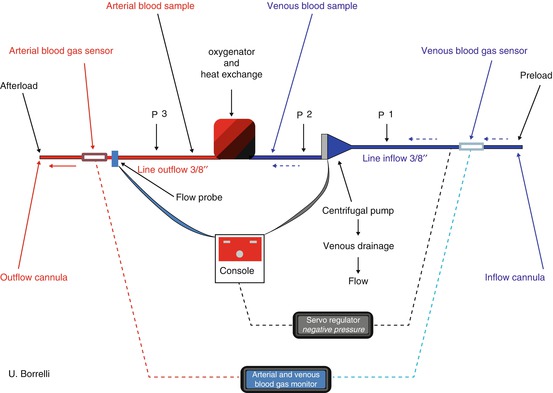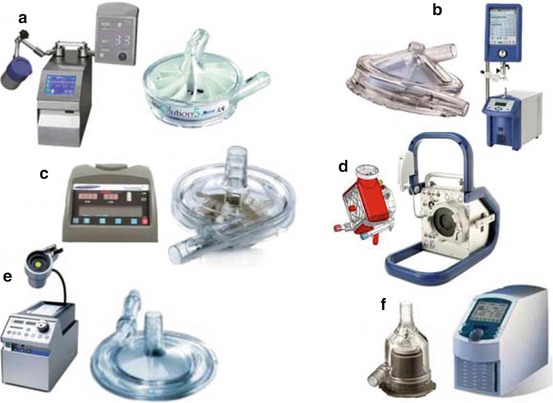Fig. 6.1
The techniques used to coat the circuits are classified into two categories: (a) Ionic bond: bond in which one or more electrons from one atom are removed and attached to another atom, resulting in positive and negative ions which attract each other. (b) Covalent bond: bond in which one or more pairs of electrons are shared by two atoms
ECMO is classified according to the connection with the blood circulation of the patient.
6.1.1 Venovenous ECMO (VV)
Used most frequently in the treatment of severe respiratory compromise, venovenous ECMO has both the inflow and outflow cannula placed in the patient’s venous circulation.
6.1.2 Venoarterial ECMO (VA)
Able to totally or partially bypass the lungs or heart, venoarterial ECMO allows for full cardiac or pulmonary support. It can be used to provide support of the vital organs, temporary circulatory support, and/or relief to the heart during myocardial recovery. Where appropriate, it can also be a bridging therapy to transplantation or establishment of a mechanical heart. During VA ECMO, the inflow cannula is placed in the patient’s venous circulation and the outflow cannula in the arterial circulation.
6.2 Biocompatible Components
Currently, there are several approaches to improve the biocompatibility of cardiopulmonary bypass components, based on the use of antithrombotic biomolecules such as heparin, polymeric molecules, and new glycoprotein molecules. Heparin is a negatively charged, hydrophilic, complex polysaccharide acid.
6.3 Example of Biocoating That Is Used During ECMO
The Carmeda coating allows heparin molecules to be attached to the biomaterial surface by a covalent bonding.
The Duraflo II heparin coating ionically attaches heparin to a quaternary ammonium carrier, which binds to the biomaterial surfaces.
The Rheoparin coating fixes the heparin molecules to the biomaterial surface, due to ionic forces.
The Physio coating is composed of a phosphorylcholine polymer. The heparin is not present in this type of coating and is based on a phosphorylcholine molecule.
The Bioline coating combines polypeptides and heparin. Polypeptides are adsorbed onto the components of the CPB surface forming a steric hindering. The heparin molecules are attached to the polypeptides via triple covalent bonds and ionic interaction.
6.3.1 ECMO Circuit for Adult Patients
The ECMO circuit for an adult patient usually consists of an inflow cannula (venous cannula), a tubing made of polyvinyl chloride (PVC) with 3/8″ of diameter, a centrifugal pump, a heat exchanger embedded in a membrane oxygenator made of polymethylpentene (PMP) membrane, and an outflow cannula that transports arterialized blood (arterial cannula).
The circuits are usually very compact, with some flexibility for transportation, mobilization, and general care of patients in the ICU. ECMO circuits have several sites for monitoring including pressure measurement, blood sampling, and the continuous analysis of blood parameters in the inflow (venous blood) or outflow (arterial blood) lines. It is also possible to connect a hemofiltration system or hemodialysis machine on the ECMO system, according to the operating characteristics of these devices. Some ECMO consoles may be equipped with a servo controller that allows control of the centrifugal pump rotations, in relation to the negative pressure (P 1) in the inflow line (Fig. 6.2).


Fig. 6.2
Characteristics of the ECMO circuit for adult patients. P 1 Negative pressure suction from the inflow line, between the inflow cannula and the entrance of the centrifugal pump. P 2 Positive ejection pressure between the outlet of centrifugal pump and the inlet of the oxygenator. P 3 Positive ejection pressure of the outflow line, between the outlet of the oxygenator and the outflow cannula. P 2 − P 3 Corresponding to the gradient of pre- and post-oxygenator pressure, it indicates the pressure drop of the oxygenator
The choice of the different components being a part of ECMO circuit is very important because it reduces the physiological impact of the assist system on the patient. Depending on the type of assistance to be performed, the selection of the oxygenator is a priority, because it represents the largest contact area between blood and materials in the circuit.
The geometry and the internal resistance of each component will induce a pressure drop that will influence the hemodynamics in the system, the management of the system and the evolution of the patient. The optimization of the position of the cannulas, the appropriate selection of circuit components and the use of the surface treatment (tip to tip) can reduce the impact of ECMO on the patient. This is comparable to an artificial reduction of the assistance time [3, 6, 8–18].
6.3.2 Centrifugal Blood Pumps
Centrifugal pumps are nonocclusive, and as such, there is a risk of inducing a backflow of blood against the current through the pump. This is the reason that some consoles are equipped with anti-reflux system. ECMO dedicated centrifugal pumps are driven by electromagnetic induction motors and uses the principles of centrifugal force to generate a flow (described in terms of liters/minute), which is created by the rotation of the cones, fins, or vanes and rotors (Fig. 6.3).


Fig. 6.3
(a) Centrifugal pump console (SCPC) Revolution of Sorin Group. (b) SCPC Affinity CP of Medtronic. (c) SCPC CentriMag of Levitronix. (d) SCPC Cardiohelp System of Maquet. (e) SCPC Rotaflow of Maquet. (f) SCPC DeltaStream of Medos
The flow is controlled by either electromagnetic or ultrasonic flow meter. Flow depends on the speed of rotation per minute (RPM) of the centrifugal pump, the hemodynamic conditions including the preload or afterload, and the characteristics of the inflow or outflow cannulas that are used including their positioning. To ensure adequate preload, the centrifugal pump and the oxygenator should preferably be below the level of the right atrium (RA) of the patient. An increase in the negative pressure suction upstream of the centrifugal pump (P 1) will be the result of a decrease in preload. An increase in the positive pressure ejection downstream of the oxygenator (P 3) is generated by an increase of the afterload. Both of these phenomena decrease flow despite a constant pump speed (RPM). It is important to check the parameters of the patient, the position of the cannulas, and the absence of kinking or clamping on the lines and of thrombi in the circuit.
A decrease in preload causing a significant increase in P 1 can induce the phenomena of cavitation (chattering) in the inflow line. This can cause major trauma to the blood, resulting in hemolysis, gaseous microemboli, and other adverse events. It is for this reason that some ECMO circuits use a servo controller to maintain a safe relationship between the pump speed (RPM) and P 1. This ensures that there is time available when preload decreases to treat the cause before cavitation and its consequences occur, thereby reducing the probability of trauma to the blood and the appearance of gaseous microemboli [9, 10, 13, 14].
Prior to stopping a centrifugal pump, it first is necessary to clamp the outflow line. Once the pump has been deactivated, the inflow line should be clamped.
6.3.3 Membrane Oxygenator
The membrane oxygenators are placed distal to the centrifugal pump. They are generally equipped with a heat exchanger made of polyurethane, polyester, or stainless steel. Depending on the model, the surface of the heat exchanger varies from 0.14 to 0.6 m2 (Table 6.1).
Table 6.1
Characteristics of the oxygenators
Oxygenators Specifications | Sorin EOS ECMO | Maquet Quadrox PLS | Maquet HLS module Integrated centrifugal pump | Medos Hilite 7000LT |
|---|---|---|---|---|
Blood flow rate | 0.5–5 l/min | 0.5–7 l/min | 0.5–7 l/min | 0–7 l/min |
Membrane surface area | 1.2 m2 | 1.8 m2 | 1.8 m2
Stay updated, free articles. Join our Telegram channel
Full access? Get Clinical Tree
 Get Clinical Tree app for offline access
Get Clinical Tree app for offline access

|